As an Australian business owner or executive, you're no stranger to the relentless pressure of staying competitive in a digital-first world. Missing growth targets due to outdated legacy systems? High operational costs eating into profits? Competitors surging ahead with sleek, AI-powered innovations while your team grapples with inefficient tools? These pains are all too real, amplified by a talent market that's evolving faster than ever. Enter AI: tools like ChatGPT and advanced coding assistants are automating routine tasks, slashing the need for traditional entry-level developers, and skyrocketing demand for AI/ML specialists. With forums like Reddit buzzing about AI "replacing simpler tasks" and X (formerly Twitter) highlighting the rise of "AI engineers," Australian businesses are facing a projected 17% growth in software engineering roles by 2033, with a strong focus on AI integration. But this disruption isn't just a threat—it's an opportunity to rethink hiring developers and build teams that drive efficiency, cut costs, and unlock profitability. In this comprehensive blog, we'll delve deep into how AI is reshaping entry-level roles and essential skills for 2026, backed by the latest data from sources like Jobs and Skills Australia and global reports, and why partnering with a trusted agency like C9 can turn these challenges into your competitive edge.
Australia's tech sector is booming, projected to reach A$167 billion in 2025 with an 8.7% annual growth rate, but skill shortages in areas like AI and cybersecurity are creating bottlenecks. According to the Australian Computer Society, firms are already hiring fewer entry-level engineers due to AI handling basic tasks, forcing a pivot to more specialised roles. This shift aligns with global trends where AI is expected to reshape half of all jobs by 2050, but in Australia, the focus is on harnessing data for profitability amid rising demand for AI-driven projects.
The Pain of Traditional Hiring in an AI-Driven Era
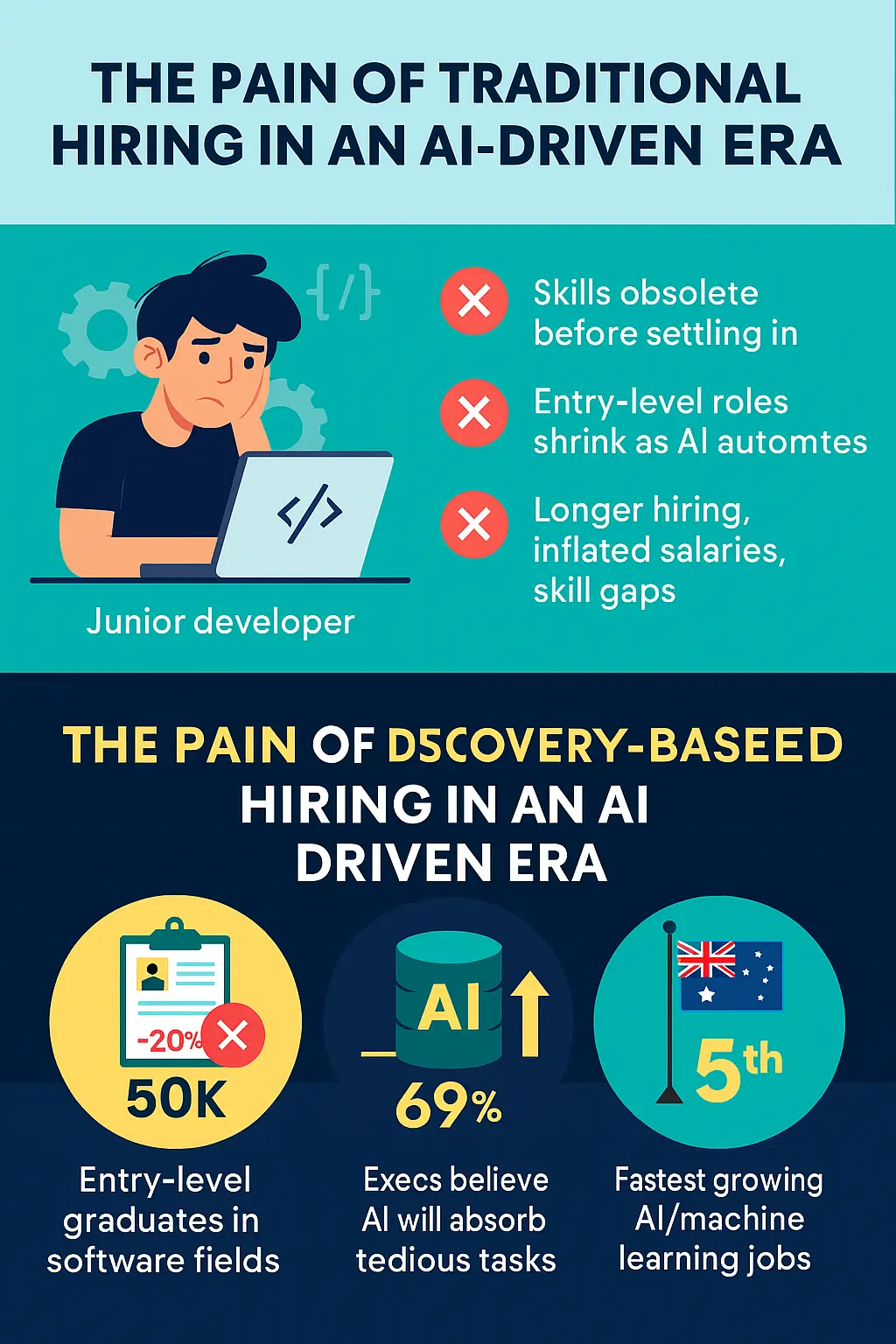
Imagine pouring resources into hiring junior developers only to find their skills obsolete before they've even settled in. That's the harsh reality for many Australian executives today. Legacy systems bog down productivity, poor tech integration leads to data silos and frustrated teams, and the lack of internal expertise leaves you vulnerable to competitors' tech leaps. Entry-level roles are shrinking as AI handles routine coding—think debugging basics or simple scripts—leaving a gap where businesses once relied on affordable junior talent. Reddit threads warn of "AI replacing entry-level jobs," while X discussions point to companies repackaging roles to demand AI fluency from day one. In Australia, where tech demand is rising amid economic pressures, this means longer hiring timelines, inflated salaries for specialists, and a scramble for skills in AI integration that harness data for real profitability.
Data from the Korn Ferry Institute shows entry-level roles are narrowing, with a 20% drop in employment for recent graduates in software fields as AI automates mundane tasks like proofing drafts and reconciling spreadsheets. LinkedIn data reveals 69% of Australian executives believe AI will absorb tedious entry-level work, allowing juniors to focus on higher-value contributions—but only if they're upskilled. Without adaptation, you're not just missing targets—you're risking stagnation in a market where AI and machine learning specialists are among the fastest-growing jobs from 2025-2030, with Australia ranked 5th globally for AI usage. The Australian tech hiring market in 2025 shows rates up 30% year-on-year to 32.3%, yet attrition holds at 19%, highlighting the need for strategic hires amid skill gaps.
Essential Skills Redefined for 2026
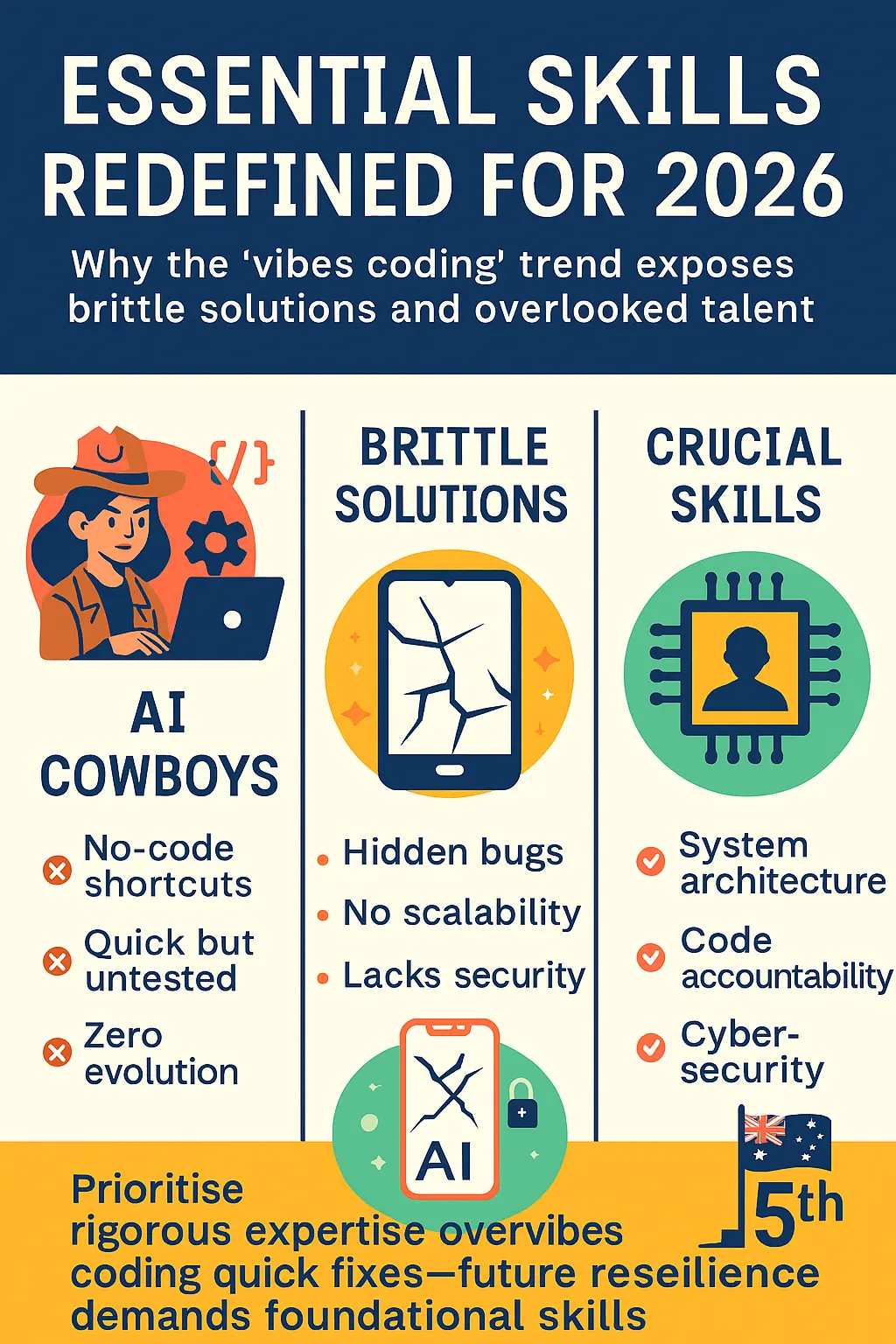
The agitation deepens when you consider the gray areas emerging in this AI boom. Enter the "AI Cowboys"—those flashy AI app builders and freelancers peddling "vibes coding," where tools like no-code platforms promise quick, cheap apps based on vague prompts and automated outputs. Slap together a solution overnight without deep expertise. But here's the thought-provoking truth—these approaches often create brittle systems that crumble under real-world stress. Vibes coding lacks rigorous testing, scalability, and security, leading to hidden bugs, data leaks, or integrations that fail when your business scales. Why the problems later? Because AI Cowboys prioritise speed over substance, leaving you with apps that don't evolve with your needs, resulting in costly rewrites, downtime, and lost revenue. Critics highlight risks like lack of accountability, maintainability issues, and increased vulnerability to security breaches, as seen in cases where AI-generated code introduced critical failures in production environments.
In Australia, businesses already battling high costs and outdated systems can't afford these pitfalls—especially when competitors are leveraging robust, AI-driven tech for sustained gains. Harvard Business Review research on over 50,000 developers shows AI flattening hierarchies, with coding time up 5% but project management down 10%, as AI handles oversight—yet without human judgment, risks escalate. X posts from industry leaders like Andrew Ng emphasise that while AI boosts productivity, fundamentals like system architecture remain crucial, warning against "vibe coding" your way to greatness without understanding computers. The global AI market is set to hit USD 3,497 billion by 2033, with Australia's AI sector growing at 15.17% CAGR, but vibes coding could expose organisations to legal consequences under regulations like the Cyber Resilience Act.
Why Discovery Calls Are Your First Step to Smarter Hiring
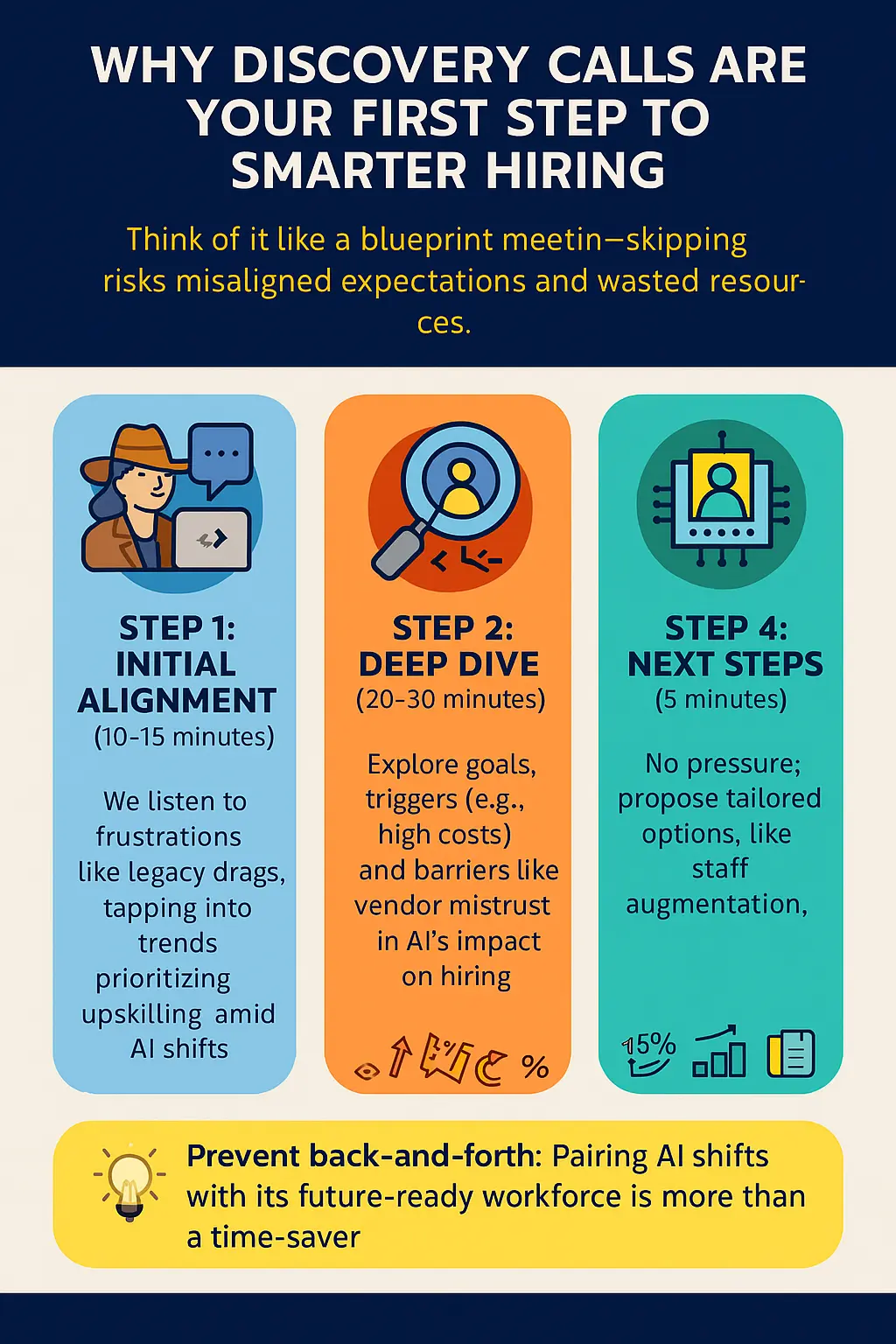
But there's a better way forward, and it starts with a simple, collaborative conversation: the discovery call. Skipping it? That's the worst idea you could make—it's like building a house without blueprints, leading to misaligned expectations, wasted budgets, and projects that miss the mark on your goals for efficiency and profitability. At C9, our discovery calls are designed to map out your pain points, decision points, and project timeline, ensuring every step aligns with your vision.
Here's a detailed breakdown of how they work:
- Step 1: Initial Alignment (10-15 minutes) – We listen to your challenges, like legacy system frustrations or tech gaps hindering growth, drawing from trends where 85% of employers prioritise upskilling amid AI shifts.
- Step 2: Deep Dive (20-30 minutes) – Explore your goals, triggers (e.g., high costs), and barriers (e.g., vendor mistrust), identifying key decision points like tech stack choices, informed by data showing AI reducing entry-level needs.
- Step 3: Timeline Mapping (10 minutes) – Outline a phased roadmap, from quick wins to long-term scaling, so you see the path to ROI, aligning with Rippling's 2025 hiring insights on addressing skill gaps.
- Step 4: Next Steps (5 minutes) – No pressure; we propose tailored options, like staff augmentation, to fit your needs.
Why isn't this a waste of time? Far from it—discovery calls save you months of back-and-forth by preventing scope creep and ensuring investments yield early ROI. They help break projects into stages (e.g., MVP launch in weeks for immediate efficiency gains, like a 15% boost from AI integrations), allowing savings from phase one to fund future improvements. In a world of AI disruption, this collaborative approach turns uncertainty into a clear, profitable strategy, as evidenced by Indeed's 2025 report on GenAI's rapid growth in Australia.
Beware the AI Cowboys and Vibes Coding Traps
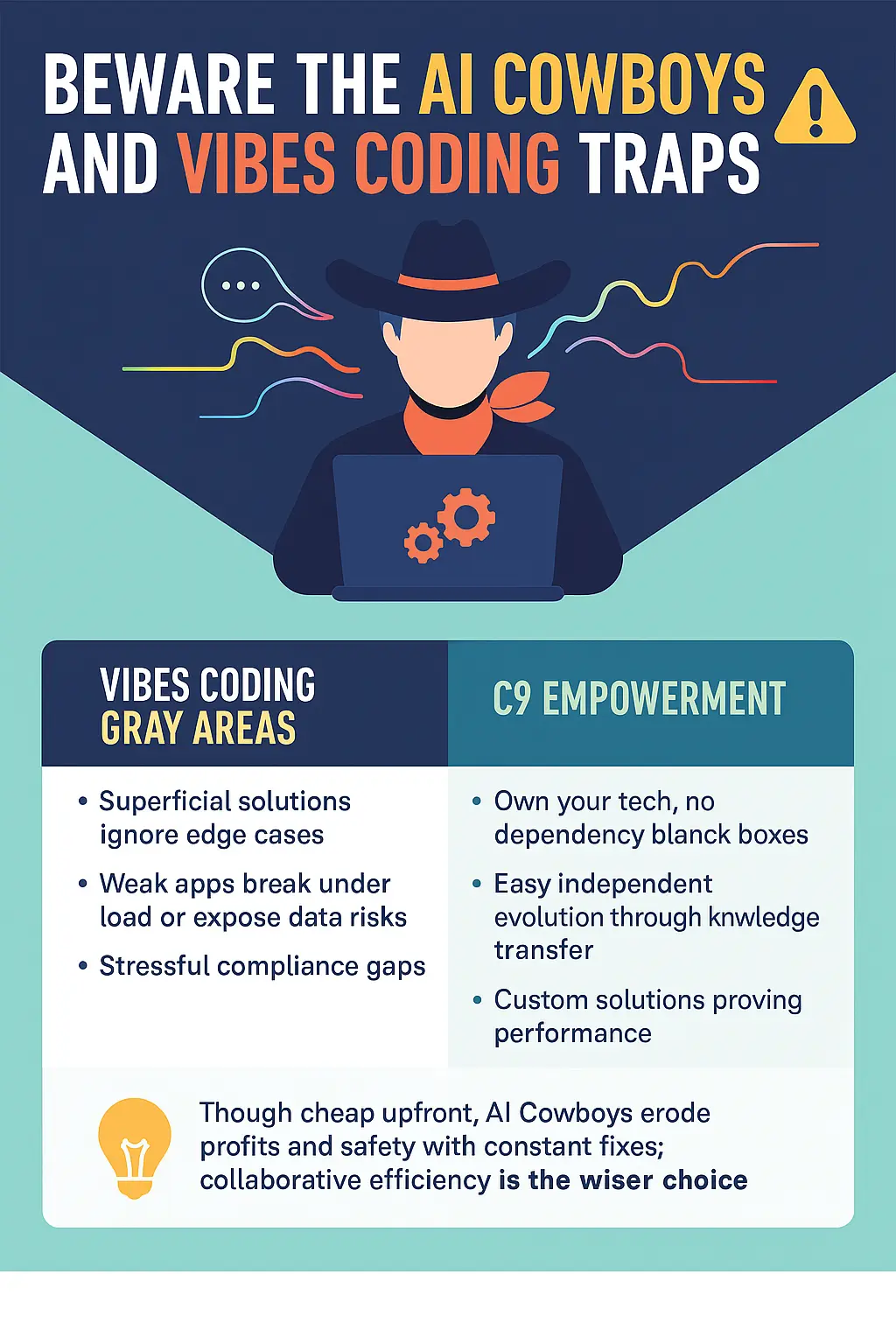
To truly empower you, let's educate on those "AI Cowboys"—the budget AI app builders and freelancers relying on vibes coding. These operators use generative tools to churn out apps based on loose "vibes" or prompts, often without understanding your business intricacies. The gray areas? Superficial solutions that ignore edge cases, leading to apps that break under load, expose data vulnerabilities, or fail compliance in Australia's strict regulatory environment. Thoughts to ponder: While they offer cheap upfront costs, the long-term headaches—think constant fixes, scalability issues, and no knowledge transfer—erode your profits and competitive edge. Security risks include introducing vulnerabilities that could lead to breaches, as AI-generated code often lacks thorough review. In contrast, C9 doesn't just build; we transfer knowledge to your team, ensuring you own the tech and can evolve it independently. This advantage means no black-box dependencies, just collaborative growth that maximises efficiency, backed by our proven track record in custom solutions.
Why Choose C9 Over Hundreds of Developers? Our Unique Edge
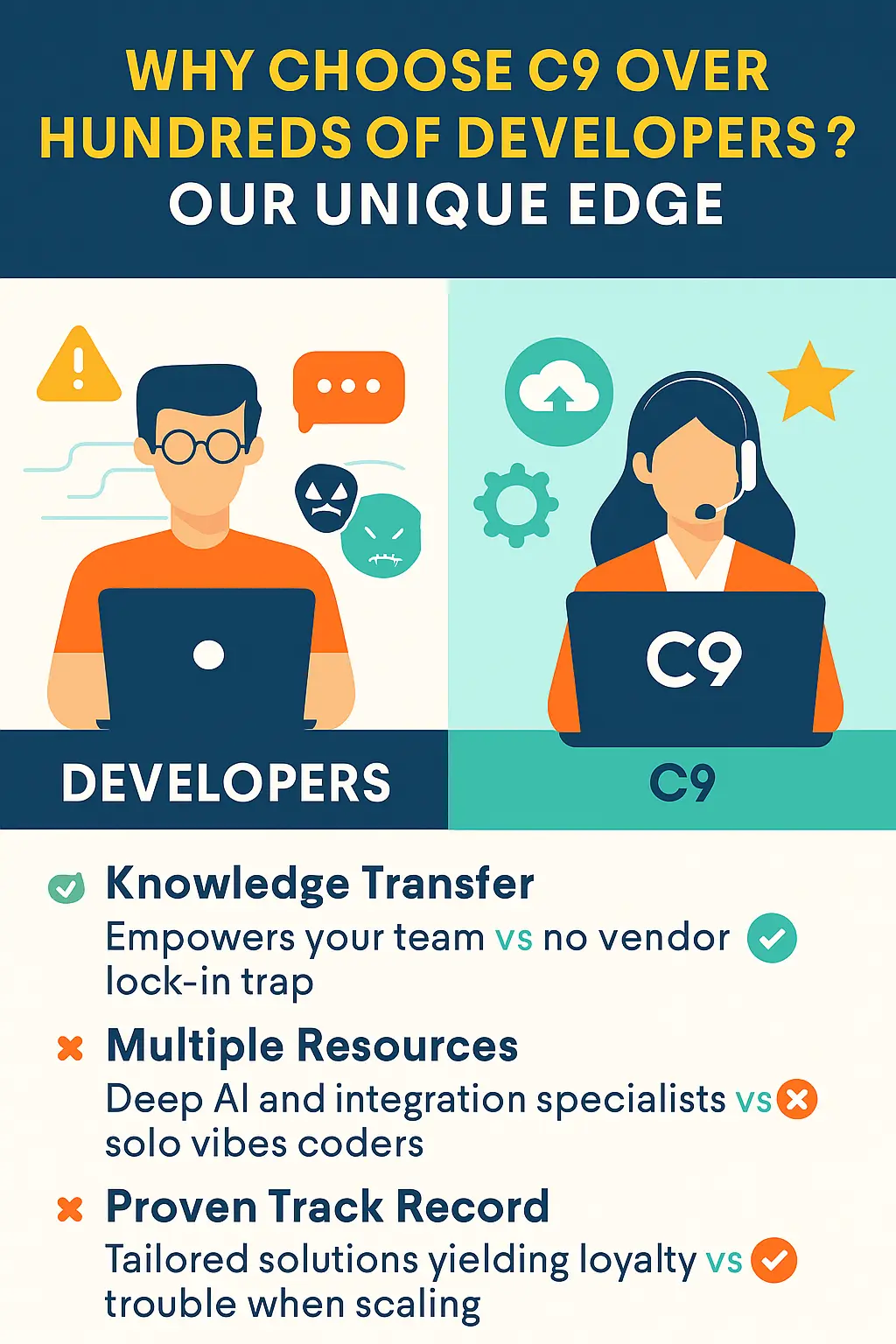
In a crowded field of developers, what separates C9 (https://www.c9.com.au/)? We're not just another vendor—we're your innovative, trustworthy partner in custom software, apps, integration, and database development. Unlike generic freelancers or AI Cowboys, we offer a blended hybrid offshore and onshore team: onshore experts in Australia for strategic oversight and compliance, paired with offshore talent for cost-effective execution. This model delivers high-quality results at up to 40% lower costs without sacrificing reliability, addressing Australia's skill shortages in software development and cybersecurity.
Our advantages shine through:
- Knowledge Transfer: We empower your team with skills and documentation, avoiding the "vendor lock-in" trap, unlike vibes coding's lack of maintainability.
- Multiple Resources: Access a deep bench of specialists in AI/ML, integrations, and more, ensuring flexibility for any project scale, aligning with 2025 trends prioritising AI and data skills.
- Proven Track Record: Tailored solutions that drive efficiency, reduce costs, and boost revenues—backed by long-term client loyalty.
Compared to others, C9's collaborative approach turns your barriers (like lack of expertise) into breakthroughs, giving you the edge in hiring developers without the hassle.
Flexible Staff Augmentation: Options Tailored for Australian Businesses
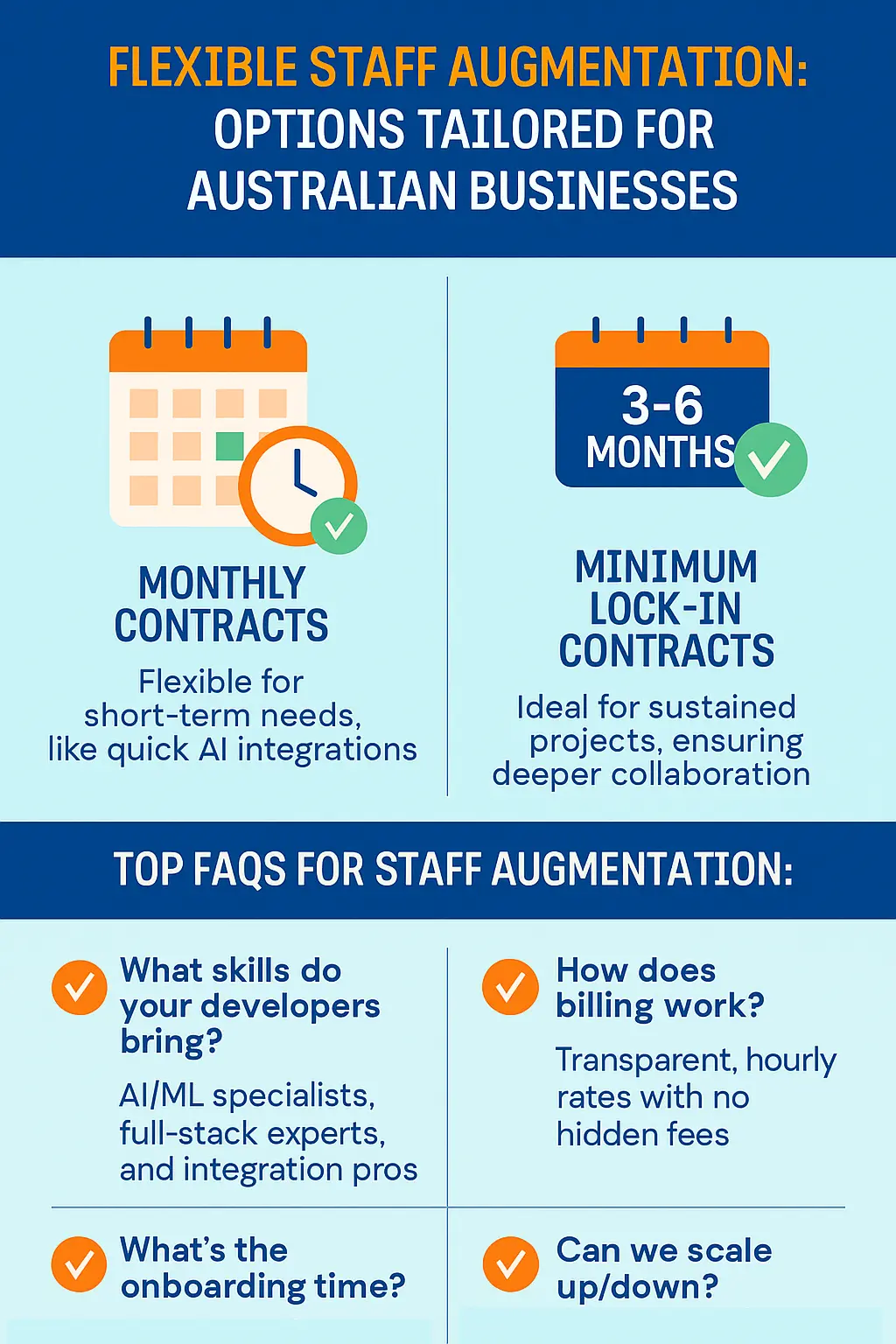
When hiring developers feels overwhelming, C9's staff augmentation provides on-demand expertise without full-time commitments. Options include:
- Monthly Contracts: Flexible for short-term needs, like quick AI integrations, suiting bursts of work in a market where GenAI is a top trend.
- Minimum Lock-In Contracts (3-6 Months): Ideal for sustained projects, ensuring team continuity and deeper collaboration.
Why are 3-6 month lock-ins better? They allow time for knowledge transfer, seamless onboarding, and measurable ROI—reducing turnover risks and costs associated with frequent rehiring, especially as AI reshapes roles. Monthly options suit bursts of work, but lock-ins foster stability, helping you hit goals like cost reduction without disruptions.
Top FAQs for Staff Augmentation:
- What skills do your developers bring?
AI/ML specialists, full-stack experts, and integration pros tailored to Australian needs, including cloud computing as per 2025 in-demand skills.
- How do we ensure security?
All work follows strict protocols, with onshore oversight for compliance, mitigating vibes coding risks.
- *What's the onboarding time?
Typically 1-2 weeks, thanks to our hybrid model.
- Can we scale up/down?
Absolutely—flexibility is built-in to match your growth.
- How does billing work?
Transparent, hourly rates with no hidden fees.
The Pitfalls of Indicative Pricing: Why Discovery Comes First
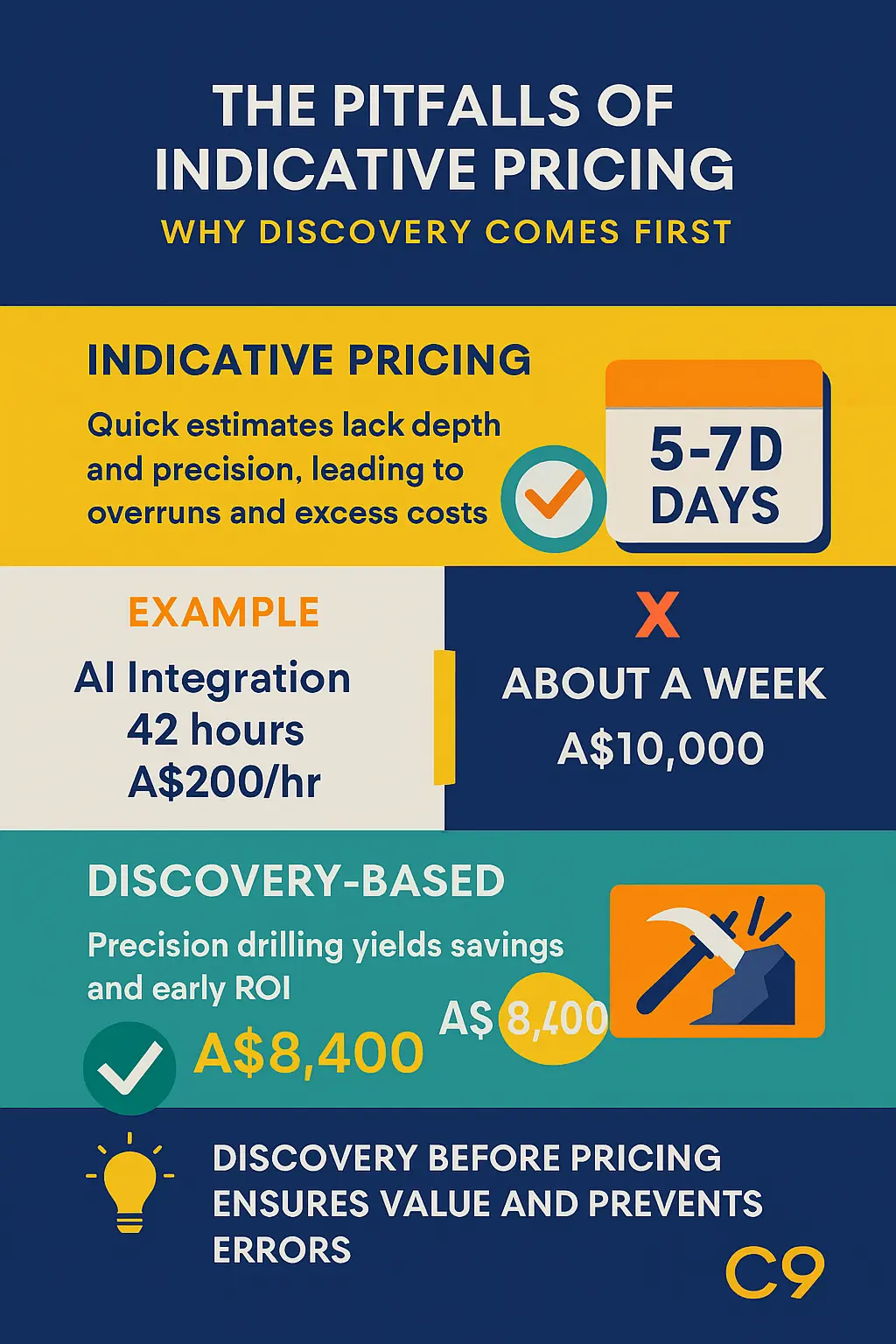
Before wrapping up, let's address indicative pricing proposals—those quick estimates often tossed out without depth. They're not worth the paper they're written on, as they overlook nuances, leading to budget overruns and unmet expectations. Indicative pricing might round to the nearest day or week (e.g., a 5.5-day task billed as 1 week = 7 days), inflating costs by 27%. In contrast, discovery-based pricing drills to the nearest hour for precision.
Example: Suppose your AI integration project needs 42 hours. Indicative pricing might estimate "about a week" (40-56 hours), charging A$10,000 flat. Post-discovery, we pinpoint 42 hours at A$200/hour = A$8,400—saving you A$1,600. This accuracy comes from breaking projects into stages: Stage 1 (MVP in 20 hours) delivers early ROI (e.g., 15% efficiency boost), feeding savings into Stage 2 improvements. Always insist on discovery before pricing—it's the key to avoiding pitfalls and ensuring investments align with your profitability goals, especially in a market where tech concerns top priorities for 2025.
Embrace AI's Revolution with C9 as Your Partner
AI is revolutionising recruitment, reshaping entry-level roles, and demanding new skills—but with the right partner, Australian businesses can thrive. From navigating AI Cowboys to leveraging staff augmentation, C9 delivers innovative, trustworthy solutions that overcome your pains and drive success.
Ready to transform your tech challenges into opportunities? Contact C9 at https://www.c9.com.au/ for a no-obligation discovery call. Let's collaborate on custom software that boosts efficiency, cuts costs, and propels your business forward—because your success is our mission.